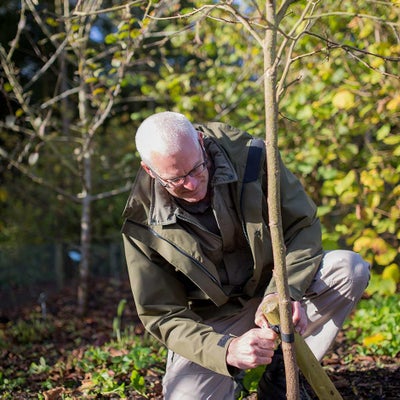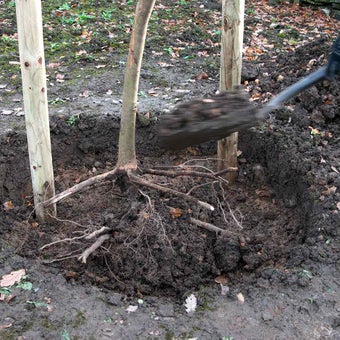
Quick facts
Suitable for - Specimen trees
Timing - Ideally October to April
Difficulty - Moderate to difficult
Suitable for...
This advice is suitable for larger-sized specimen trees, whether containerised, or root-balled.
When to buy and plant specimen trees
Purchase and planting is best done between November and March. and root-balled trees are only available in autumn and early winter and they should be planted immediately.
If adverse weather conditions such as frozen or soil delay this, they can be heeled in (temporary planting in more favourable soil perhaps in a raised bed to prevent the roots drying out) until planting is possible. Take care to avoid disturbance of root-balled trees in particular, covering roots with straw or bracken for protection.
How the trees are grown
You will find trees offered in one of three ways;
Bare-rooted trees: Young bare-rooted trees one-to-three years old establish well, but are increasingly difficult to obtain compared with container-grown stock. Pre-ordered bare-rooted stock is usually available from about November and should arrive wrapped in polythene to prevent the fibrous roots drying out. The tree should have a well-developed root system spreading evenly in all directions. Do not buy trees with ‘hockey stick’ roots, where all the growth is on one side. Early planting will allow some root growth before temperatures rise in the spring.
Root-balled trees: Larger semi-mature trees and some evergreens, especially conifers, are available root-balled. This is where the root system has been held in place with fabric and, sometimes, wire mesh. Root-balled trees have usually been ‘undercut’ (root pruned) or several times to encourage the development of a fibrous root system. They often establish better than container-grown trees as they have been grown in soil in the open ground rather than commercial potting . Although these trees are relatively expensive, the fibrous root system remains more intact. Buy and plant root-balled trees when , in autumn or early spring, following the same criteria as for and container-grown trees.
Containerised trees: With pot-grown trees it is vital to remove any excess compost from above the root collar (the point just below which the roots naturally start to grow). If the tree is planted to the original level of compost in the pot, as usually recommended, it could already be too deep. Secondary roots are common in pot-grown trees, originating from the buried part of the trunk. These should be pruned off close to their point of origin.
Thoroughly tease out the roots. Do not be afraid to open up a congested root ball using a sharpened piece of to disentangle the roots if necessary. If this is not done, the roots will frequently fail to grow out into the soil and the tree will fail to establish. Any damaged roots should also be trimmed back.
How to select and buy specimen trees
Selecting and buying specimen trees is not always straightforward. The following points need to be taken into consideration:
Height and spread: This is probably the most important factor. Make sure you select a tree which has an ultimate height suitable for your garden. Even small ornamental trees may, over 20 years, reach a height of 6-7m (18-21ft) or more.
Season of interest: Consider when you want your tree to look good, thinking about flowering time, foliage, fruit and bark. If you only have room for one tree, look for one with more than one season of interest such as fruit or autumn colour following on from flowers.
Condition: As you will be spending a lot of money on one tree, check that it is in good condition. There should be a well-balanced branch system and no wounds or damage to the , or dead or distorted foliage.
Access: Check the practicality of bringing a large tree into the garden; confirm access and proximity to drainage channels and services (e.g. drains and cable lines).
Site preparation: Plants will not grow where soil contains too little air, insufficient or where it is very dry or wet. Pre-planting soil preparation should aim to improve these conditions.
Plant as soon as possible: Arrange delivery after you have thoroughly prepared the site and are ready to plant.
Planting
Planting a large tree can seem daunting but here are a few steps to getting it right;
- Water thoroughly before planting. With trees, always soak the roots (if they look moist, soak for half an hour. If they look dry, soak for up to 2 hours).
- Remove the tree from its pot or fabric wrapping (some specimen tree suppliers specify that the wrapping must be left on under the terms of their guarantee, but normally fabric wrappings should be taken off).
- Tease out the roots to get an idea of their spread and to encourage side shoot formation.
- Dig a planting hole that is no deeper than the roots, but is up to three times the diameter of the root system.
- If the sides or base of the planting hole are compacted, spike the soil with a fork before planting. Do not dig over the base as the disturbed soil will settle – resulting in the tree sinking too deep after planting.
- With container-grown trees, scrape away the top layers of to leave the uppermost roots just beneath the soil surface. A tree should never be planted deeper than the original soil level as this can lead to plant failure (see Problems, below).
- Place the tree in the planting hole and refill the hole carefully, replacing soil between and around all the roots to eliminate air pockets.
- Stake your tree to help anchor the roots whilst allowing the trunk to flex in the wind.
- Alternatively, use a ground anchor. Ground anchors are essentially underground staking systems. They offer discreet anchorage of the and are particularly useful for specimen trees or those in highly visible areas where above-ground methods would be unsightly. Tree anchors must be fitted at the time of planting. Systems such as the Platipus Tree Anchor and biodegradable tree anchors made from potato starch are available.
Aftercare
Aftercare is doubly important for specimen trees as the establishment phase can be longer (three years or more) than with smaller trees.
Watering: Drought stress is common with newly planted trees (in the first three years), particularly when specimens have a large root-ball. Dry, windy conditions are especially likely to lead to water shortages so correct watering is essential.
Watering aids can assist watering of newly planted trees such as irrigation tubes ( tree irrigation pipe made from potato starch is available) or watering bags such as Treegator®.
Fertilising: Top-dress in late winter with proprietary general fertiliser granules at a rate of 50-100g per sq m (1½-3oz per sq yd).
Weeding: Keep a vegetation-free circle of at least 1.2m (4ft) in diameter around the tree to avoid competition for water from weeds, lawns and other plants.
: After feeding, apply a layer of mulch around the tree in late winter, which will help to conserve moisture and suppress weeds. Make sure you leave a collar of 10cm (4in) around the stem of the tree to prevent the mulch causing the to rot.
Windbreaks: In exposed sites, young trees benefit from a temporary windbreak for two or three years until they are established. Use suitable fabric netting on the windward side attached to strong stakes, driven firmly into the ground.
Tree guards: In some areas it is necessary to protect young trees from damage caused by rabbits or other animals. Either surround the tree with a barrier of wire netting secured to stakes or place a proprietary tree guard around the tree trunk.
Problems
Specimen trees tend to be expensive so recognising problems early is key to success.
Establishment: Good growing conditions are essential to get your tree off to the best start once planted into your garden or containers. Ensure it has adequate water, fertiliser, light and good soil to begin with, and you shouldn’t encounter many problems.
Plant failures/plant guarantees: For such a large investment in individual plants, check the guarantee before you buy. Some nurseries only guarantee specimen trees if their landscape team have planted them (and possibly carried out regular maintenance visits to check the plant is being cared for correctly).
Planting too deep: This is a common cause of tree death. It is imperative to plant at the same depth that the tree was growing in the nursery.
Pests and diseases:
Deer, rabbits and voles can readily ring- a young tree so fitting a tree guard immediately after planting is vital.
Brown leaves can cause worry, as can a greyish-white coating to the foliage which usually indicates a problem with powdery mildew.
More serious still are soil-borne diseases such as phytopthora root rot that can lead to plant death and vascular diseases such as verticillium wilt.






